
- Main Idea Worksheets
- Capitalization
- Alphabet Coloring Pages
- Preschool Letter Worksheets
- Bubble Letters
- 5 Letter Words
- Words for Kids (A-Z Word Lists)
- Days of the Week
- Phonemic Awareness Worksheets
- Phonics Worksheets
- Sight Words
- Kindergarten Spelling
- 1st Grade Spelling
- 2nd Grade Spelling
- 3rd Grade Spelling
- Anchor Charts
- All About Me Templates
- Christmas Worksheets
- Cursive Writing
- Frayer Model Templates
- Fun Fact Friday
- Main Idea Graphic Organizers
- Noun Worksheet Maker
- Printable Lined Paper
- Reading Logs
- Sight Words Bingo
- Writing Prompts
- By grade, concept, theme
- By Common Core Standards
- By NGLS Standards

Book Report Templates
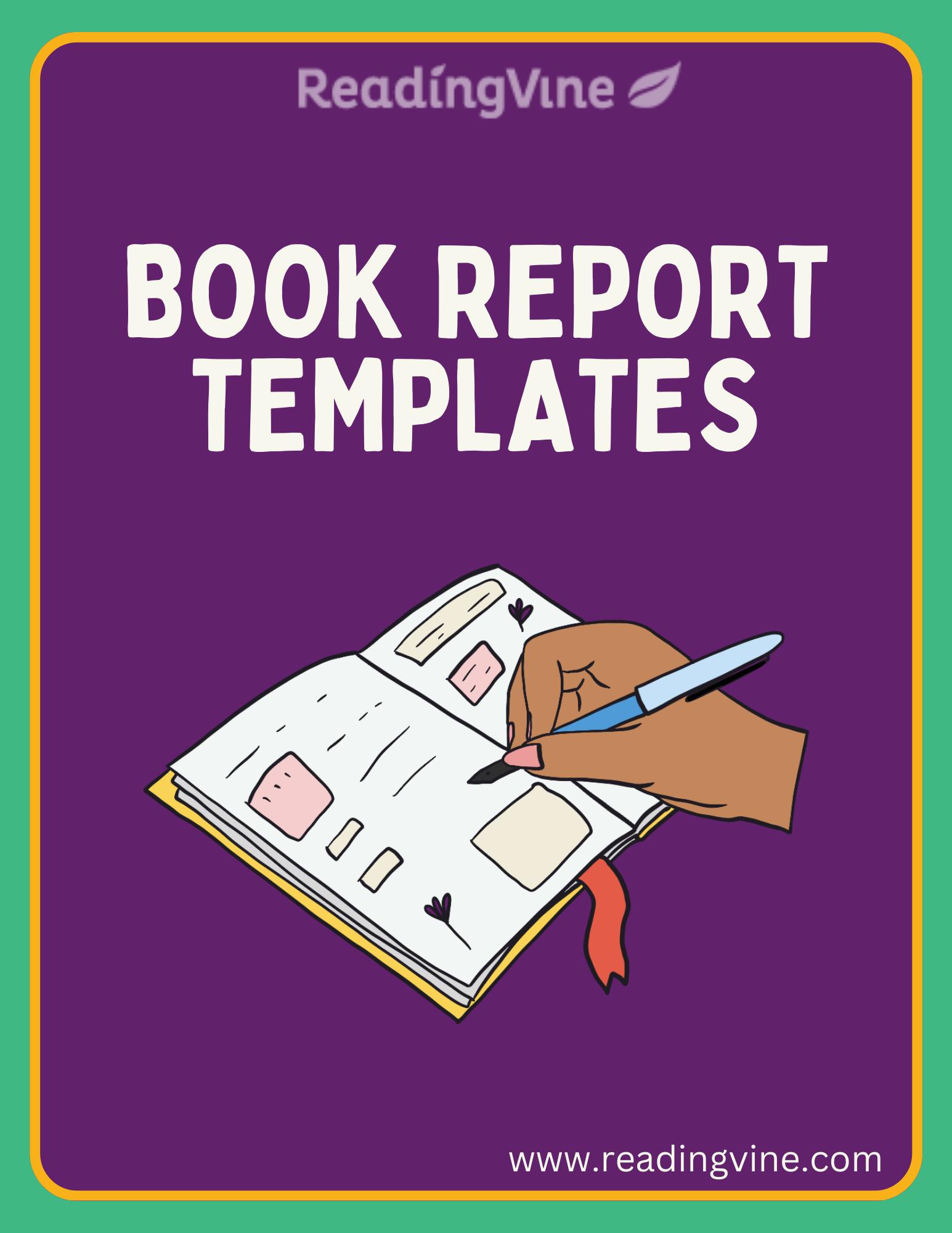
Book reports often ask students to summarize, reflect, and share their ideas. We’ve created a series of book report templates that you can use or adapt based on a variety of learning needs. While this task may reflect individual preferences and insights, it can be collaborative. Students can share in gallery walks, small groups, or large groups. Displaying book reports near your classroom library can allow you to curate a more meaningful classroom book collection and allow peers to interact in an unexpected way. Some of the earliest work with longer writing tasks is cultivated through the experience of crafting a book report. No matter how young your learners may be, fostering a love of reading and providing opportunities for children to write about what they read is critical.
Book Report Templates (Printable PDFs)
One of the most important steps of helping students understand how to craft a book report lies in their ability to choose the books they read and how they want to report on what they’ve learned. It is always useful to review book report options together in class in order to create a firm foundation that students can return to again and again. Since book reports can be a staple task in many elementary school classrooms, offering choice in how students craft and create reports will make the experience more engaging.
We’ve created a variety of printable book report templates below for different learners. For instance, we have an English language and Spanish language book report template that students can use to document character names, setting, and reflect on their favorite parts of a text! Additionally, we’ve crafted book report organizers for fiction and nonfiction texts, so you can appeal to learners who love different genres and make your curriculum more inclusive. Finally, we’ve also created a few options for those students who need more challenge. In these book reports, students extract quotes of significance, analyze them, and offer their insights on what the text teaches readers.
All of our book report templates encourage students to reflect on their interest in the text. This is critical for their reflection and ability to connect with their reading experiences.
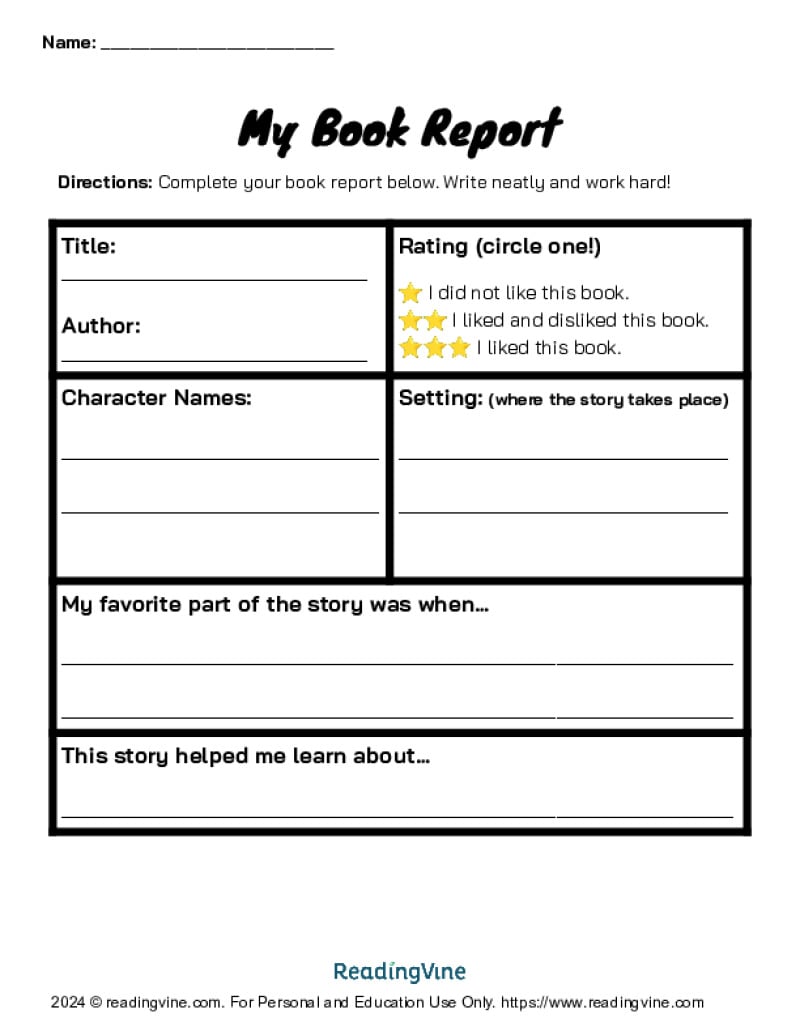
Students complete the book report by writing the title, author, Character names, setting and their favorite part of the story.
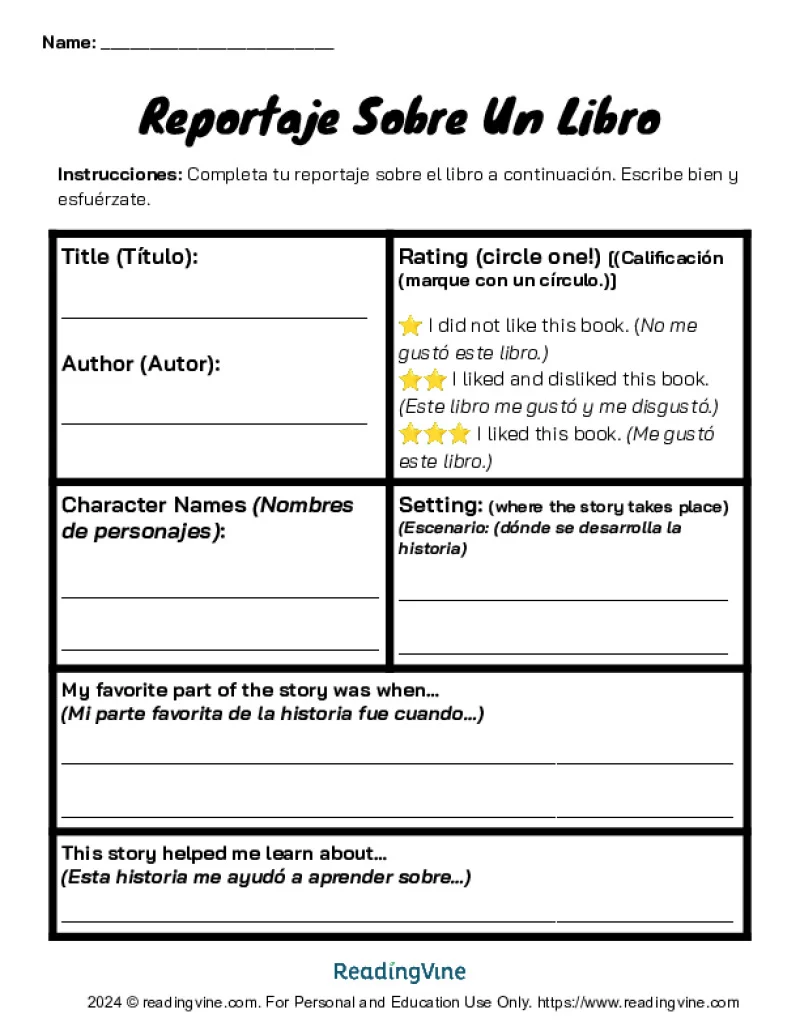
This is the same book report template but in Spanish.
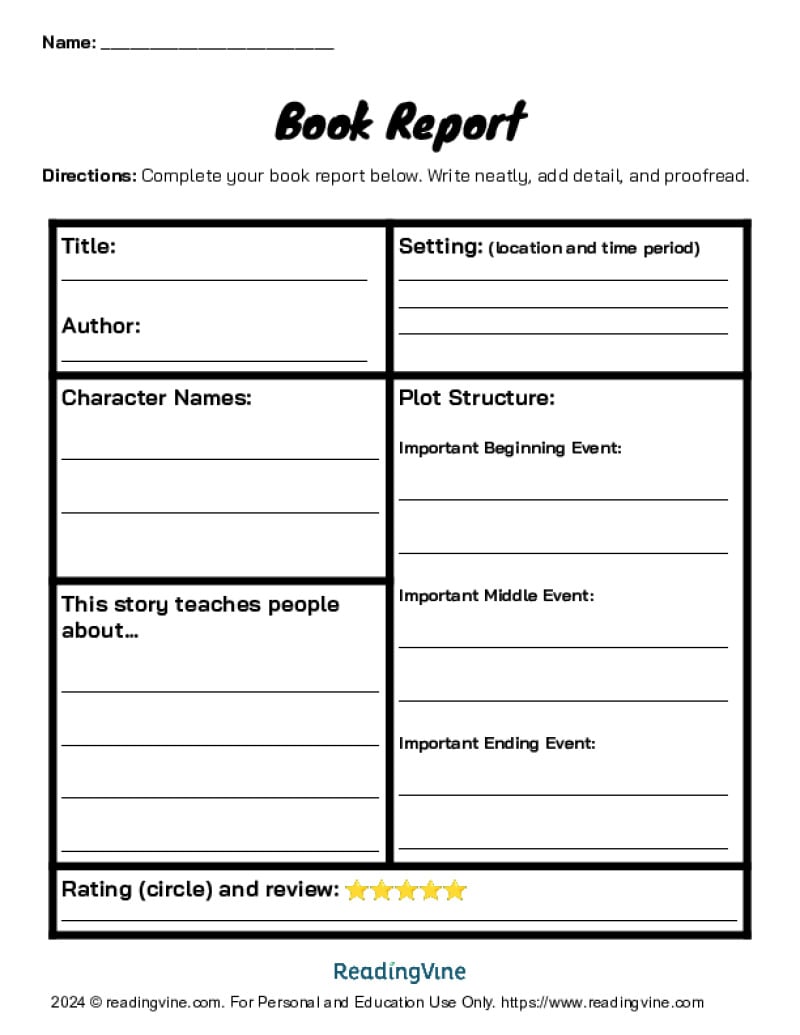
With this template, 4th - 5th grade students enter the title, author, character names but also enter the plot structure and what the story can teach people. Students also rate the book.
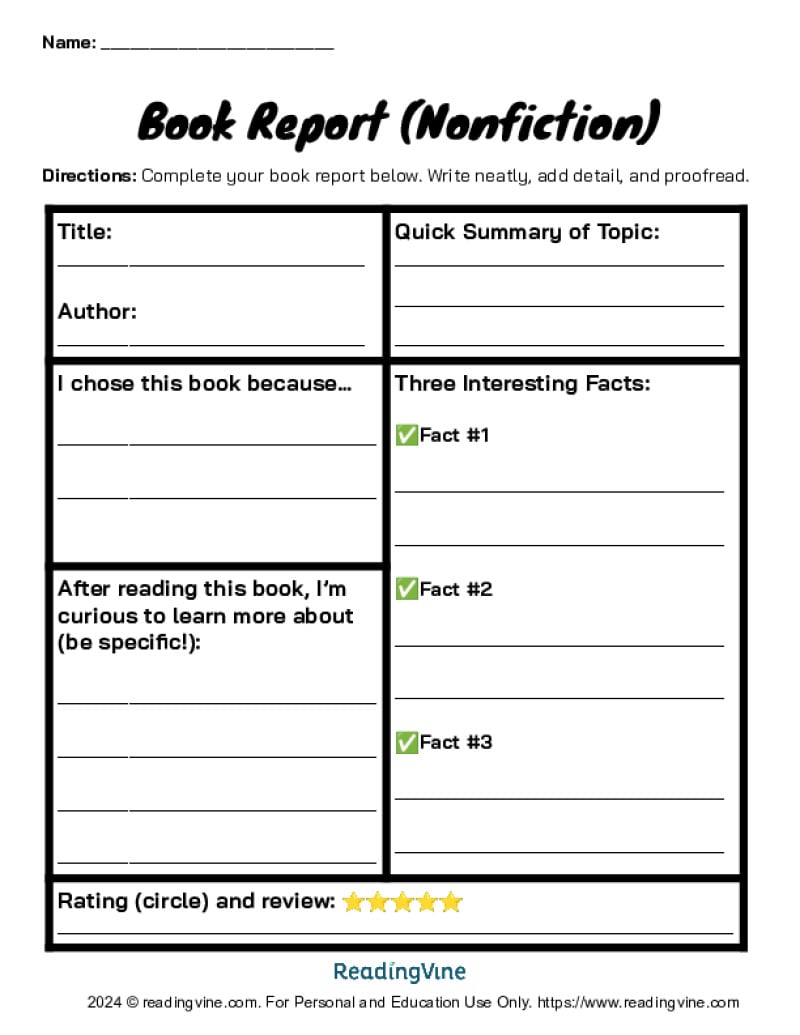
A template for nonfiction books. The student enters basic book information plus three interesting facts and what they are most curious about after reading the book.
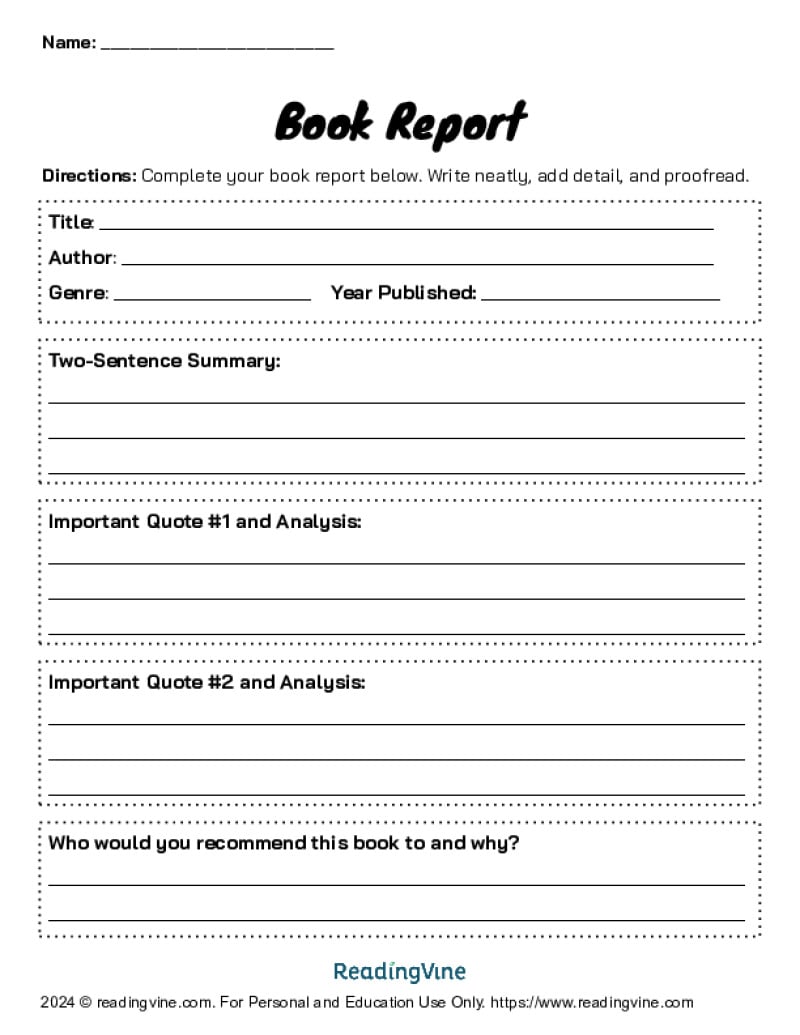
With this 6-8th grade template, students write a two-sentence summary, important quotes and whether they recommend the book and why.

Students explain, in two sentences, what the text is about, identify three important events in the text, and choose one quote they think is most important and then analyze its importance.
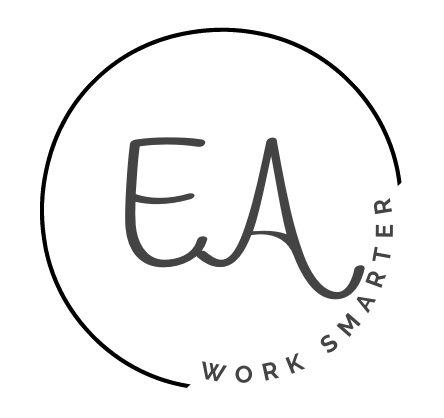
Elementary Assessments
11+ Free Book Report Templates For Students
If you’re looking for student book report templates, you have come to the right place.
I have compiled some of the best free printable book report templates that encourage students to showcase their reading comprehension skills and knowledge of any book – fiction or nonfiction.
These book report templates include pages that reinforce a variety of reading skills, prompt critical thinking and help students structure information in a meaningful way.
What’s more, they are suitable for all ability levels of students – from struggling to gifted and talented learners.
So if you are a teacher looking to assess students’ literacy abilities in a way other than assigning over-the-top book report projects, then these ready-to-use templates are a perfect fit.
Using them, students will be able to produce something great.
Book Report Templates
Book reports usually include…
- Title and author,
- Summary of the book,
- Story elements (characters, setting, problem, solution), and
- Recommendations.
However, the possibilities are many as to what information students report from their books.
In order for students to write a book report in a meaningful way, try one of the following book report templates which include written and visual formats that appeal to a range of learning styles.
These graphic organizers are suitable for young readers as well as older readers.
1. Book Report Timeline
This book report template is a timeline that reinforces the literacy skill of sequencing. It includes spaces for students to record six main events.
The steps flow in a vertical manner from the top of the page to the bottom of the page with transitional words (first, next, finally, etc.) used throughout in order to guide students along.

This very simple but effective book report template is best suited for younger students.
It will help them to synthesize information, reflect upon the story, and think about which ideas from the book are most important.
2. 5Ws Book Report
The 5Ws book report template, which works well with fiction and nonfiction texts, is great for younger students because it guides them in answering basic questions derived from who , what , when , where , why , and how .
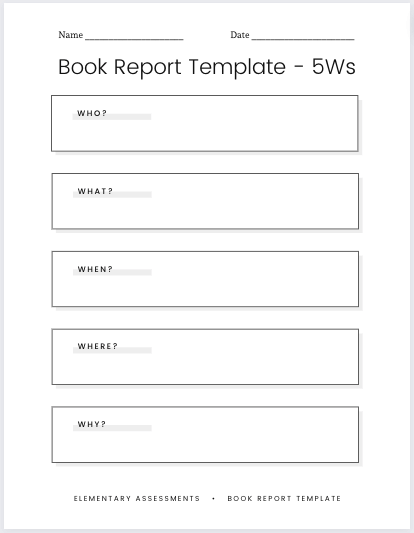
After reading a book, students will generate questions using the question stems and answer them on the book report template.
Because students can create their own leveled questions , this template is great for differentiating instruction because it serves well both advanced and lower-performing students.
3. Book Report Story Elements
If you seek simple book report templates, this one is a good fit.
Because students learn the story elements relatively early in their school life, this book report project template makes a great review activity.
Using the template, students will identify the story’s author, illustrator, characters, setting, problem, and solution.
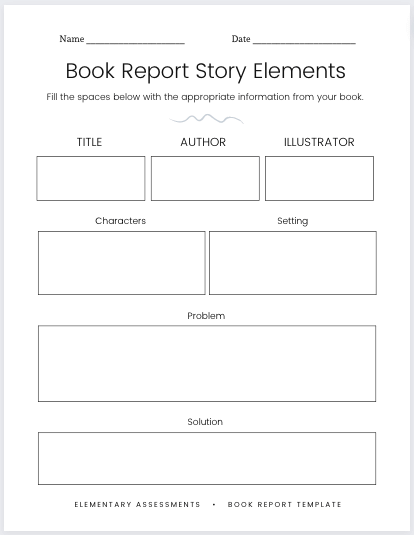
4. Book Report Vocabulary Squares
In each of the six squares, younger students will write and sketch important words from their books.
Examples of words students may choose…
- New words learned
- Confusing words
- Review words
- Words they figured out using context clues
- Figurative language
They will write the words in the boxes and then sketch each of them.
As an extension, have students complete a book report vocabulary squares template for each chapter or section of their books.
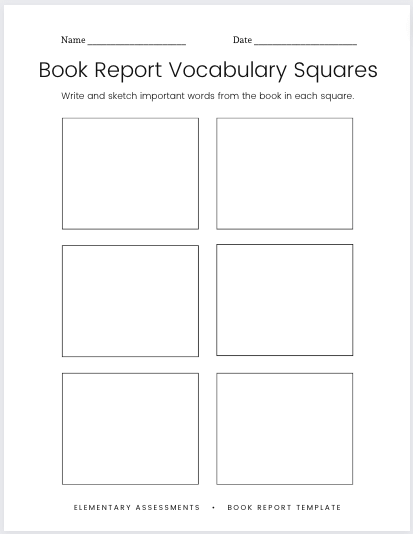
5. Book Report Sequencing
To have young readers practice sequencing and main idea, provide them with this helpful book report sequencing template.
It’s straightforward and provides transition words to guide them along.
Use for both fiction and nonfiction books.
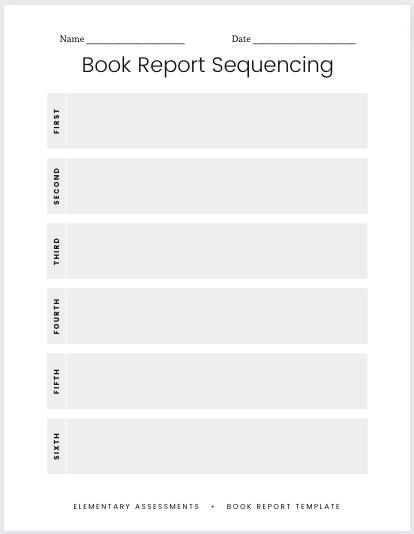
6. Book Comparison
Students will analyze two books by the same author and complete a Venn diagram that shows how the two books are alike and different.
Afterward, they will summarize the information in paragraph form.
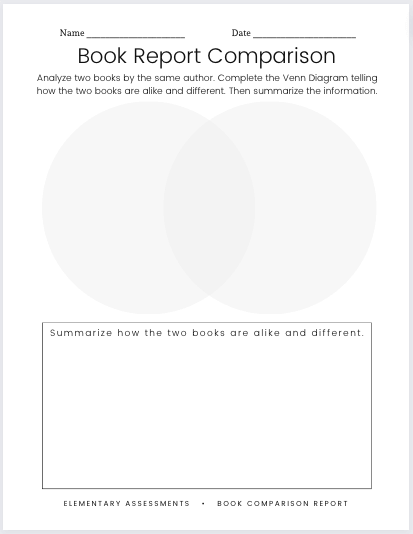
Comparison activities serve well as critical thinking exercises because they prompt students to reflect upon similarities and differences among themes, authors, characters, books, etc.
As an extension, encourage students to compare several pairs of books by the same author (e.g. Gail Gibbons books ) in order to observe recurring themes, the author’s writing style, similarities among characters, etc.
7. Sketch and Summarize
Using the sketch and summarize template, students will sketch the characters, setting, problem, and solution in the squares with the matching number.
This graphic organizer reinforces the story elements plus summarizing and can be used for all ability levels and grade levels.
Remind students that a summary includes only the most important events from a book.

8. ABC Book Report
ABC books aren’t just for younger students. They work well with elementary, middle, and even high school students!
This type of reading project promotes critical thinking, reinforces a variety of literacy skills, strengthens vocabulary, and engages students to the max.
What’s more, this activity is able to be differentiated for a range of ability levels since students are the ones who choose the words for their books.
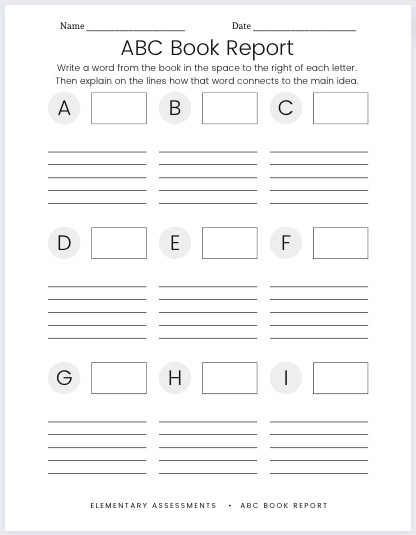
To use this template, students will brainstorm a significant word from their books for each letter of the alphabet.
They will record each word in the rectangle to the right of each letter. Then on the lines below, they have to explain the reasoning behind that word selection.
Remind students that all the words they choose must be connected to the book in some way.
Encourage them to provide “deep connections” instead of surface-level surface connections.
9. T-Shirt Book Report
If you desire creative book report templates, try this one.
Provide guidelines so that students know what information to write on each part of the T-shirt.
For example:
- Sleeve one: title of the book
- Sleeve two: author and illustrator
- The main part of the T-shirt – a summary of the book, figurative language, important vocabulary, facts, opinions, book recommendations, confusing parts, favorite parts, etc.
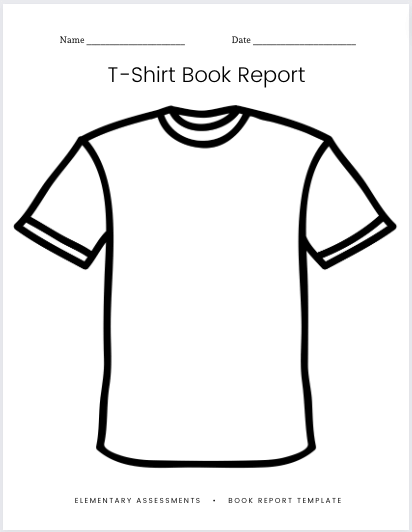
There are many ways to structure information for the T-shirt book report template.
As an extension or to make the assignment more challenging, ask students to complete a T-shirt for each chapter or section of their books.
10. Sketch and Caption
This book report template is perfect for lower elementary students.
They will sketch a picture in the space at the top of the page that shows the main idea of their books. Then they will write a caption or description to accompany the drawing.
Consider having students present their book projects to a partner or the class.

11. Research Book Report
After reading a nonfiction book, students will choose a topic related to the book that they would like to explore further.
As an example, if a student is reading about Martin Luther King, Jr., they may want to research segregation, racism, peace, etc.
As they conduct research, they will record six facts on the template and then create a drawing that represents the topic.
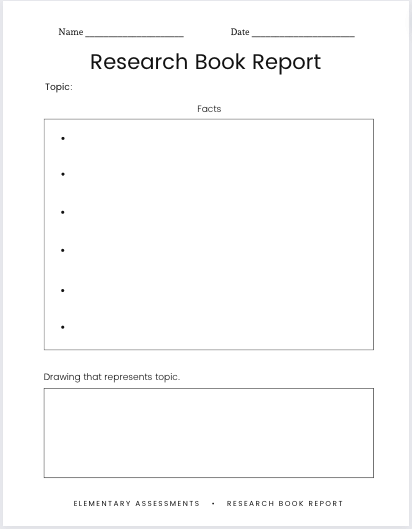
12. Book Review
Book review templates work well for all grade levels.
After reading a book, prompt students to reflect on what they liked and didn’t like about the book.
This book report template provides space for students to record the title, author, illustrator, plus summary of the book.

Additionally, they will rate the book using a 5-star rating system, describing what they liked/disliked about the story thus providing a balanced perspective.
As an added bonus, place these recommendations on a bulletin board so that classmates get ideas for future reads.
Final Thoughts
Boost literacy skills, tap into different learning styles, and save time planning book project ideas by using these printable and free book report templates that come in a variety of formats.
They meaningfully engage all ages and ability levels.
Published in
Book Templates
22 Printable Book Report Templates (Worksheets) – Word | PDF
Writing a book report is something that many of us have been tasked with before, particularly as students. A book review works as a succinct summary of the story of a book, and its characters, its plot, its core themes, message, and much more, and is a convenient yet effective way in which readers may convey what they took away from a particular piece of literature. Additionally, it allows readers to be critical of the works they read, giving it an added degree of depth and importance.
Writing a book report is an important part of academia, and also has a ton of application within the professional world. For these reasons, we’re going to take you through a comprehensive guide with which you can easily write a book report on just about any literary work.
What is a Book Report?
As the name suggests, a book report is pretty much that – a report on the experience a reader had with a particular piece of literature. Most often, a book report contains basic details on the book and author – information on the author’s upbringing, inspiration, education, and professional background are all very relevant to a book report. Generally, a solid and comprehensive book report contains the following elements:
- A succinct and brief summary of the plot or the core philosophies that are outlined in the book.
- A personal, individual analysis of the various themes and topics covered in the book.
- A personal and deep analysis of the numerous characters and/or personalities explored in the book.
- Background information that went into the publication of the book, such as information about the author, historical context, political movements, and the like.
- A final statement on why the writer of the report found the book interesting or uninteresting, complete with critical viewpoints backed up by excerpts from the book.
These elements are necessary for writing a comprehensive book report. In the next section, we’ll guide you through the process of writing the book report.
How Do I Write a Book Report?
Before you get started on the book report itself, it is a good idea to compile all your thoughts on the book into a brief set of notes that you can easily refer to. Additionally, you can list any ideas and/or critical viewpoints you may have, allowing you to easily reference different sections of the book in the report.
Once you have your summary and your notes on hand, you can get started with writing the book report. Follow these tips and format in the specified order to write an effective book report;
- Introduction – The introductory paragraph should declare the name of the author, date and year of publication, publisher, country of publication, and any other relevant historical information. Typically, this includes a small background on the author, the historical context of the time it was written, and the situation of the country in which the book was written. Once that’s done, you’re ready to move onto the next section.
- Next, you should present an overarching summary of the book. For fictional works, this means that you should write down an in-depth synopsis of the story, whereas non-fiction works generally merit a break down of the theories, philosophies, accounts, and general themes explored in the book.
- The next section accounts for the report writer’s personal opinions and experience with the book – In this section, you should outline what you thought about the book and why. Then why is particularly important in writing an effective book report – Your opinions, claims, criticism, and praises should all be backed by references taken from the book, such as excerpts or quotations. Tie this into the historical background of the author and the work itself to write an even more effective book report.
- Bibliography – While this may not particularly hold true for all fiction works, it is very common when dealing with non-fiction works. Often, multiple sources are cited in non-fiction works, which may encourage the reader to do some literary exploration and delve into other authors. When this happens, some of these discoveries are bound to tie into the book review. When these sources are used, make sure to cite them categorically and add a bibliography page.
These are the steps you need to follow to write an effective book review. Once you’ve finished writing it, make sure to do a thorough proofread, while also checking for logical follow from start to finish.

Book Report Templates & Examples
Following are free downloadable book report templates and examples that can be downloaded for free:
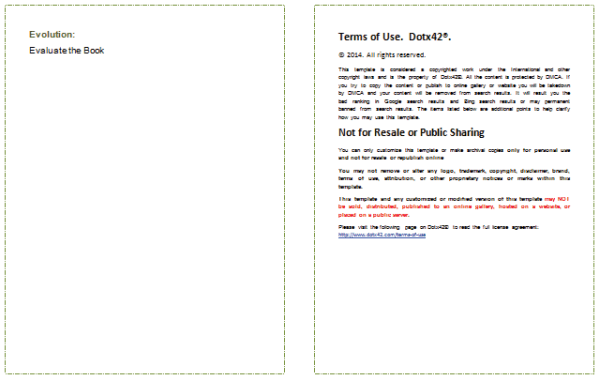
Frequently Asked Questions
What is the format of a book report.
Typically, a book report is formatted academically. This includes an introduction, a summary of the work itself, the author of the report’s opinions, findings, criticisms, and praises, and finally, a review and summary of the author’s arguments. It is typically formatted with a 1 or 2-pt margin, with double-spaced fonts like Times New Roman or Arial.
How do you write a book report?
A book report is a comprehensive summary of both the book itself, as well as the reader’s thoughts, opinions, and experience reading the book. As a result, it should contain information on the book itself, including the background of the author, a summary of the key aspects of the book, and well-reasoned, logically sound arguments made by the writer of the report. Check out our guide to find a step-by-step guide to writing a book report.
How many pages should a book report be?
Most commonly, a book report falls between 800-1,000 words. If the font is Times New Roman, 1-pt margins, and double-spaced, which is the academic standard, this comes up to a page count of 3-4 pages.
Keep reading
Coloring book templates – entertainment for kids, 16 exclusive guest book templates – editable – word, 20 free guest book templates (word | excel | pdf), free phone book templates (word | excel), 20 free address book templates.
22 Book Report Templates
In tackling coursework, you may have to dig a little bit into a book or some other kind of literature. This could be with the aim of gaining deeper insight on a matter, drawing connections between the contents of the book and the subject at hand, and so on.
What is a book report?
The above tasks require a book report. This is an essay that discusses the contents of a given book. It is largely written as part and parcel of a class assignment that is issued out to students in school, especially at the elementary level. It is shorter and less comprehensive than a book review.
How to write a book report?
To write a book report, you need to follow the steps below:
- Draft an introductory paragraph. This captures the basic information about the book such as its genre, title, author, year published, number of pages, and the publisher. Include some interesting background information about the author of the book.
- Next, incorporate a plot summary. It is basically a summary of the book itself with regards to the themes, plot, and the characters that are found in it plus the roles they play there.
- Carry out some character analysis of the main characters who dominate and play critical roles in the book from the start through to the finish line.
- Point out the themes of the book i.e. the main ideas that run throughout the story from the start through to the finish.
- Place your personal evaluation and conclusion at the tail end of the report. These two give your own opinion of the entire book and what it does have to offer to any reader.
Book Report Templates
These are frameworks against which the book reports are drafted. They serve as rough guides through which the tiny details are filled out. The templates cheapen the task of drafting a report of this kind while also seeing to it that the outcomes are largely accurate.

Guide: How to draft a book report
Different reports have different outlines and contents. Thus, there is really no unifying way of drafting the report. Nonetheless, there are some common steps that cut across the board. Below, we highlight and explain them:
- Jot down the first draft of the book report. This acts as a spark from which the subsequent reports are drafted and originated.
- Prepare the introductory paragraph of the book report. Remember, it is this introduction that sets the tone and the overall theme of the report going forward. It has to be brief but include every aspect of the report altogether.
- Now get to the core business of the report altogether. Here, you should read the book, garner the finer details and jot down its summary.
- While at it, draft the main portion of the book report, explain the main characters, highlight and explain the main themes of the book, point out any quotes, and comment on the writer’s writing style.
- Give the book a personal evaluation. This one mainly aims at commenting on the book in its entirety while also providing your own review and testimonial about the book as a whole.
- Edit and revise the report before submitting it. As you do so, see to it that you weed out any grammatical and spelling mistakes that may be present in the report.
What is the format of a book report?
The format of a book report refers to the outline that the report follows from the introduction to the conclusion of the book. Even though different reports follow different formats, there are common contents that cut across the board. These are:
- The kind of book report you are drafting
- The book’s title
- The author of the book
- The times that the story is taking place
- The location of the story of the book
- Names and descriptions of the characters in the book
- Quotations and examples from the book to provide support to your opinions
How long should a book report be?
Generally, you should keep your book report as short as it can practically be. A length of about 600-800 words would be suitable. Also, the report has to be double-spaced and drafted in legible fonts.
Final Thoughts
Drafting a book report is not a walk in the park. As a starter, you may have to devote much of your time to write it several times before mastering the art well. We ask you to carry out mock writing to deepen your understanding of the matter. Seeking the assistance of a trained expert may equally do the trick.
How did our templates helped you today?
Opps what went wrong, related posts.


23+ Business Travel Itinerary Templates

Apology Letter For Bad Behavior – 7+ Samples & Formats

Restaurant Employee Evaluation Form

Peer Evaluation Form: Templates and Examples

Free Newspaper Templates

40 Free Event Program Templates

44 Open House Sign in Sheet Templates

22+ Free Packing Slip Templates
Thank you for your feedback.
- Grades 6-12
- School Leaders
Get this FREE poster mailed to your school! ✨
Free Book Report Templates: Printables for Grades 3-5 for Fiction or Nonfiction Books
Take a new spin on your book report assignment. 📚😍
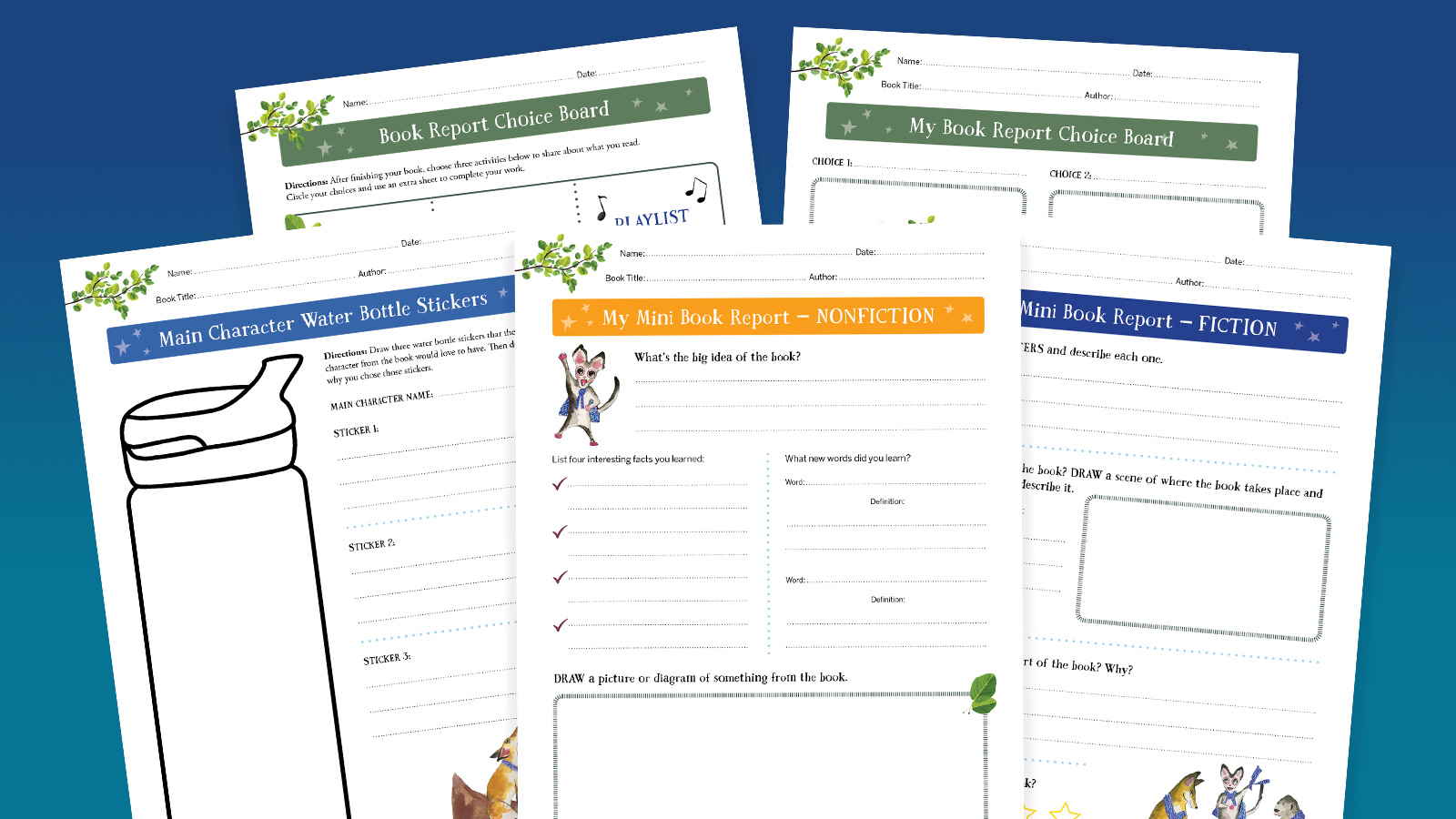
The Nocturnals are fun-filled animal adventure books with companion nonfiction for elementary school classrooms. Check out The Nocturnals World , a resource hub with free turnkey printable activities and educator guides, and browse The Nocturnals bookstore!
Building lifelong readers is one of the most important things we can do in our classrooms. The benefits of reading are wide-ranging, from improving vocabulary skills to boosting cognitive development, concentration skills, and curiosity for learning. So, how do we get young learners excited about reading and sharing what they’ve learned? Check out our free book report template printables .
Four different activities are ready to print to help you take a new spin on your next book report assignment for fiction or nonfiction books. Students will love filling in their mini book report one-pagers or making their selections from the choice board to share details about what they read.
Worksheets Included:
My mini book report—fiction and nonfiction.
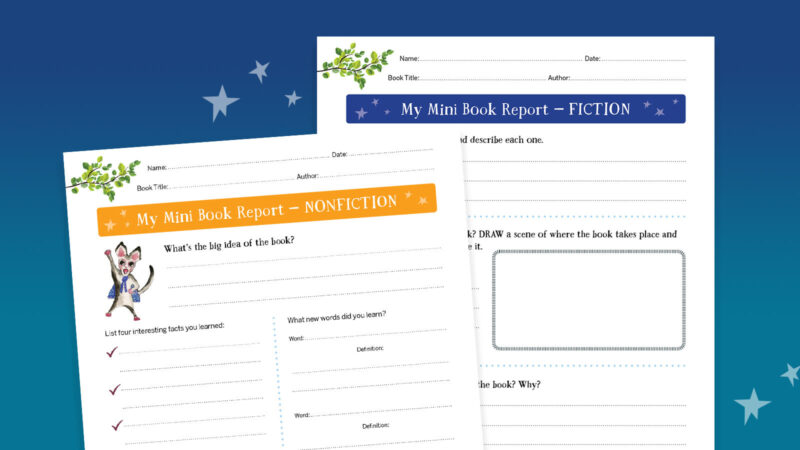
These book report one-pagers are a great way for students to reflect on their readings as they complete different sections of the worksheet. There’s a version for both fiction and nonfiction.
Book Report Choice Board
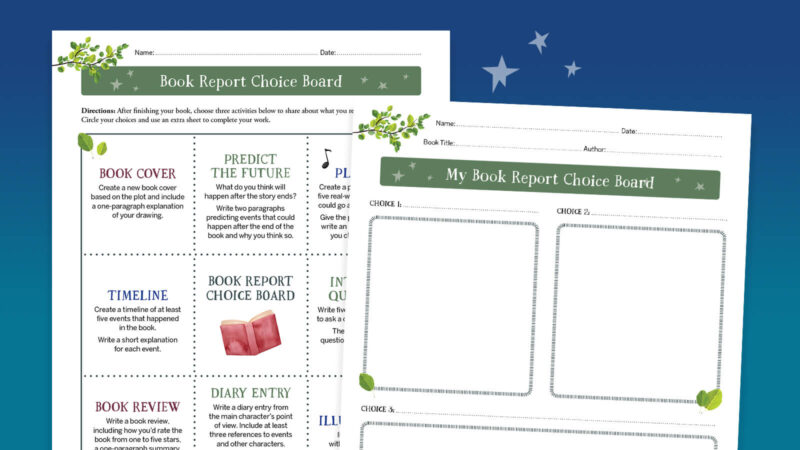
Give students choices on how they want to complete their book report assignment. This choice board offers eight fun options, from designing a comic to creating a playlist or writing interview questions, so students can let their creativity guide them.
Designing Water Bottle Stickers
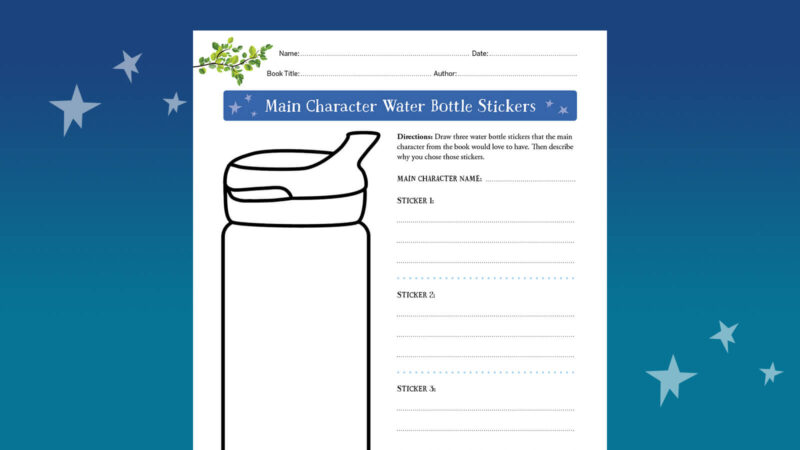
Students are obsessed with stickers. In this unique activity, students will design water bottle stickers that the main character of the book would love to have, along with a short description of their choices.
Give students fun-filled books to choose from
Animal adventure books from The Nocturnals are the perfect way to get your upper elementary students excited about reading. Paired with nonfiction companion texts that explore nocturnal animal facts, this series is great for hi-lo readers. Visit The Nocturnals World for more free printable activities and educator guides.
You Might Also Like
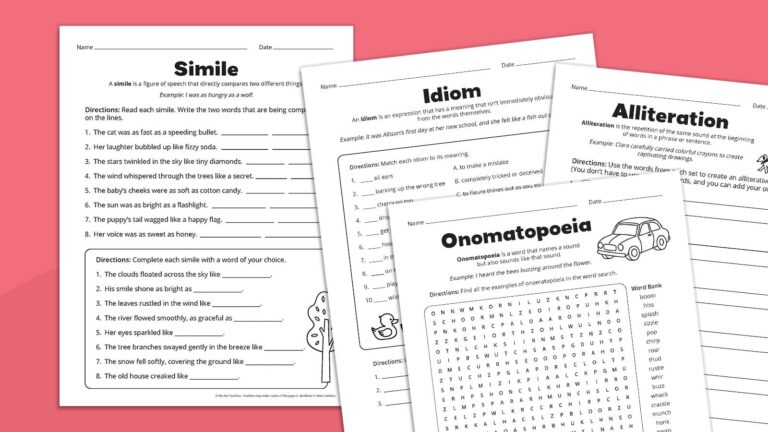
Teach Figurative Language With Our Brand-New Worksheet Bundle
Just in time for Poetry Month! Continue Reading
Copyright © 2024. All rights reserved. 5335 Gate Parkway, Jacksonville, FL 32256
- TemplateLab
Book Report Templates
30 book report templates & reading worksheets.
Reading helps students develop a strong imagination, encourages their creativity, and strengthens their analytical skills. Teachers assign a lot of book reports to ensure that students read lots of books, especially at that critical early age when they are still trying to master the written word. To cut down on some of the workload, students and teachers can find a book report template to download and fill in. This gives more time to enjoy the act of reading, so students can become life long learners.
Table of Contents
- 1 Book Report Templates
- 2.1 Why Provide A Book Report Form
- 2.2 Sections Of A Simple Book Report
- 2.3 Sections Of A Multi-Page Report
- 3 Sample Book Reports
- 4 Difference Between The Book Report Types
- 5.1 What To Do Once You’ve Written The Report
- 6 Book Report Examples
- 7 Tips for Teachers
- 8 Tips for Students
What Is A Book Report
A book report is typically given as an assignment to students in elementary and middle school. Students fill out a form answering basic questions about the book they were assigned to read. Turning in the report serves as proof to the teacher that the student read the book and, hopefully, got something out of it.
These reports may ask students to detail what the book was about, the names of the main characters, what the theme of the book is, and where the events are set. Some reports may ask specific questions about events or characters to ensure that the students read the book all the way through. The report can also help students understand the book better by asking them to think about its meaning and the plot.
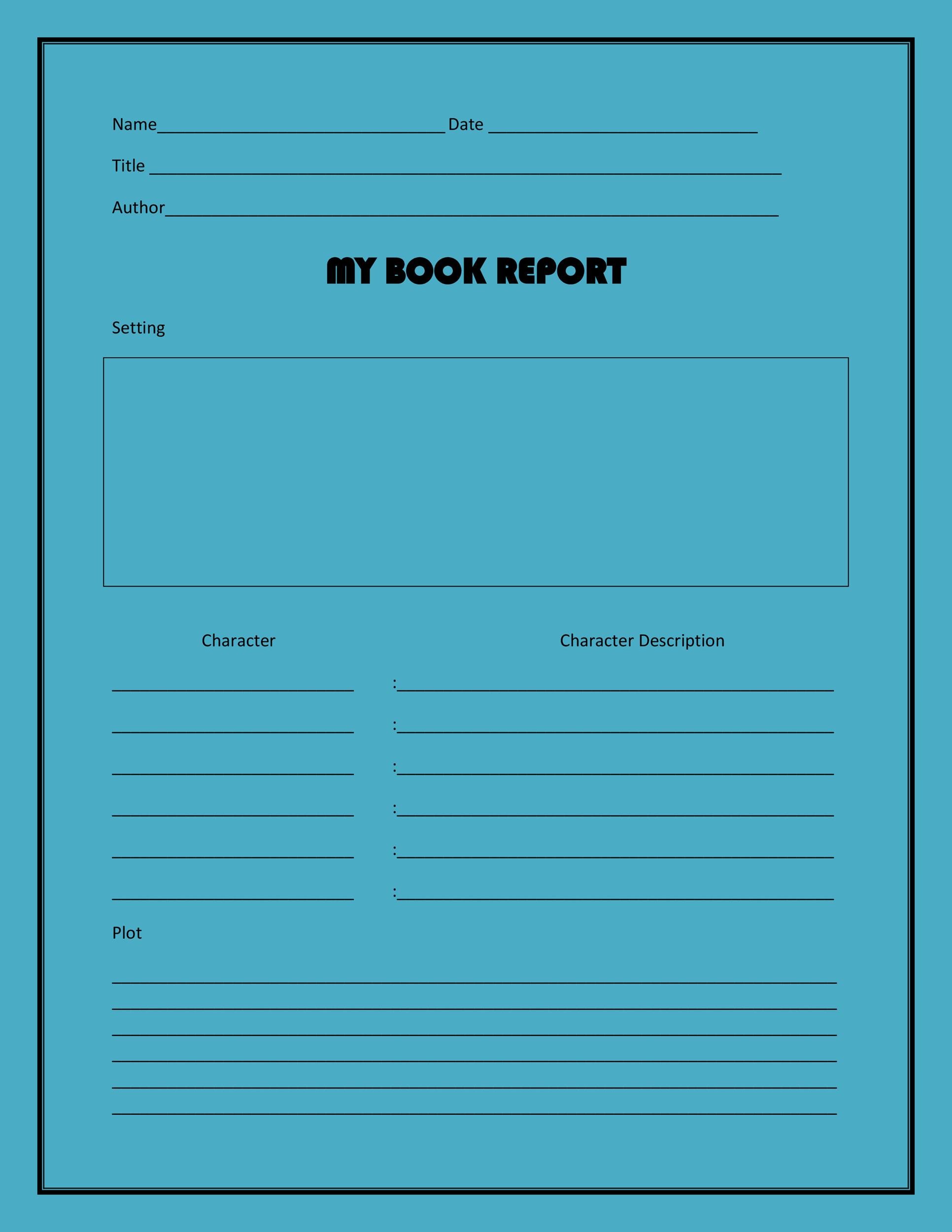
Reading Worksheets
Teachers may also hand out worksheets for students to complete in class or as homework. These are usually limited to the earlier grades when students are still learning to read. Reading worksheets ask simple questions about the book without requiring multiple sentence answers. These questions may ask students to name a favorite character, or mention the main conflict in a few words.
It’s not uncommon for the teacher to read a picture book with the class and have students fill out a worksheet afterwards. If the classroom has a bookshelf, there may also be a ‘Reading Time’ when students pick out a book to read. When they finish, the students fill out the worksheet and submit it to their teacher.
Why Provide A Book Report Form
Book report forms are a popular choice of assignment for elementary school classes. These forms make it simple for students to complete the report by filling out the worksheet. These sheets can be generic with standard questions, or teachers may create a unique sheet with questions specific to each different book that is assigned.
These forms also help introduce students to the idea of a book report format and show them what kind of information may be expected on longer, multi-page reports that they are expected to complete in the higher grades. A form is also easier to grade , especially for teachers who have a large classroom and more assignments to go over than usual.
Sections Of A Simple Book Report
A simple book report features a few sections that ask students to answer questions in paragraph format. These each ask students to detail a different element of the book. All book report forms will ask for the title, author name, and the illustrator’s name, if it is a picture book. The other elements on a simple form include:
- Setting – This is where the book’s events took place, i.e. New York.
- Characters – A list of who the main characters are and their names.
- Plot – A basic overview of the major events in the book.
- Your impressions – Whether you like the book or not, and why.
A simple form may also just ask the students to describe the beginning, middle, and end events of the book in three questions. Students may also be expected to identify the climax, which is the most intense point of the book where the main character’s problems are resolved or made worse. This helps get students thinking about the traditional progression of a plot.
Sections Of A Multi-Page Report
Eventually, teachers transition students to writing a multi-page book report. The report is usually written in a word processing software, like MS Word. Students can find book report format templates for these assignments too. These longer reports are written out in paragraph form. The teacher asks the students to address different elements of a book in their own words or with their own formatting. A simple way to organize these reports is to divide them into three basic sections, the introduction, main body, and conclusion. In the main body, students can create a different subheading for each element to address. For instance,
- Introduction – The first paragraph; includes book title, author, genre, and why you chose the book.
- Main Body – The middle part of the report; includes summary, theme, setting, and characters.
- Conclusion – A short summary of the book report and opinion of the book.
Sample Book Reports
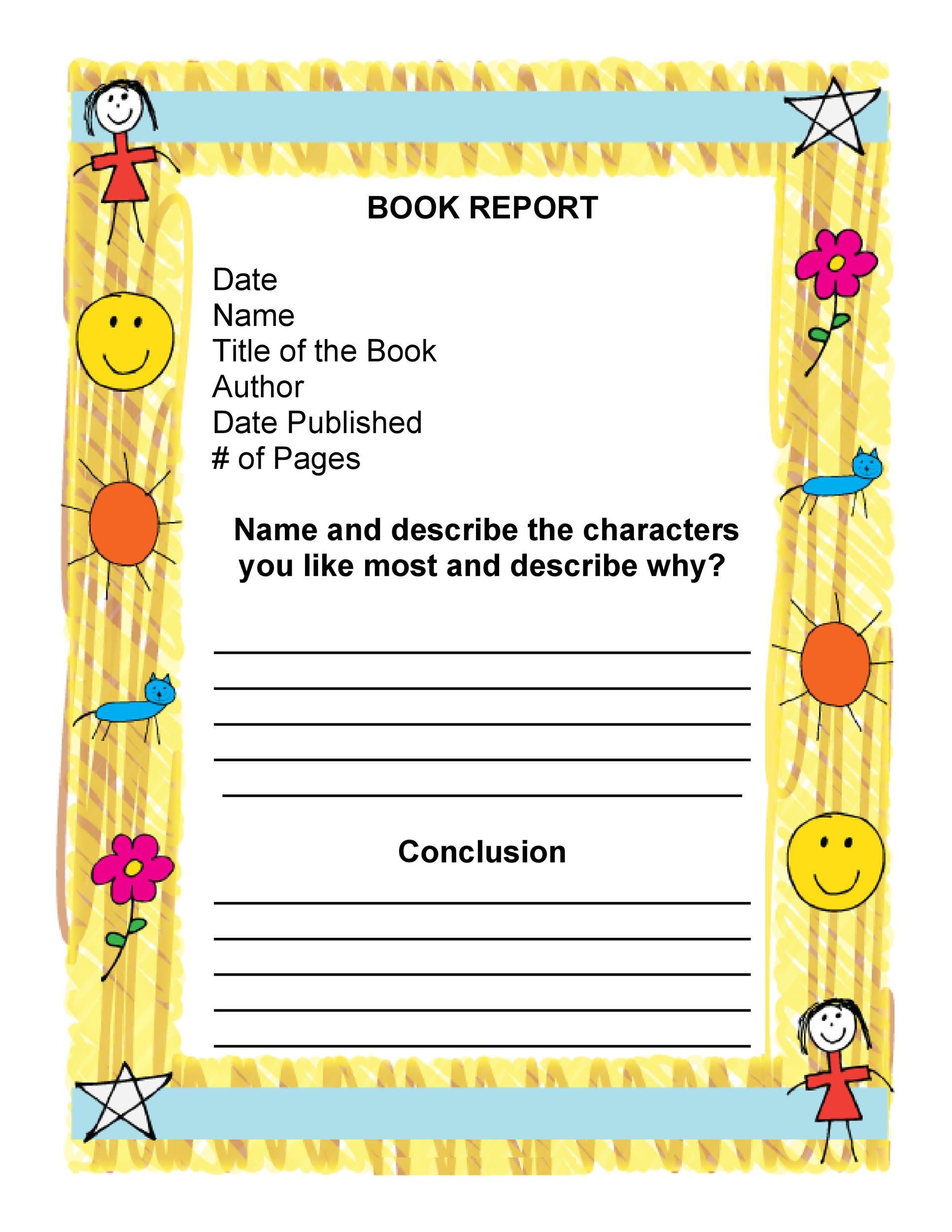
Difference Between The Book Report Types
The short book report form is handed out by the teacher and can be completed in one night like a homework assignment. A multi-page report is created by the student and may take more than one night to finish.
Short templates are available in lots of fun book report ideas suitable for young children. They have questions with a few lines to hand write the answers in a few short sentences. Some templates may include activities to make them more interesting to students, such as having them draw out a scene from the book or re-write the ending.
Multi-page reports start out as two page reports and gradually increase in size through middle school and high school. Of course, those two page reports are just as difficult for young students as the five page reports are for high school students . The great thing about these assignments is that students are usually free to organize their book report ideas however they desire. They can create bold sub-headers for the main body of the report. Students can write about the theme, characters, and setting separately. Or they can leave out the headers and devote their report to a specific element, such as the book theme. This allows students to weave information about characters and setting into the report where they are most relevant to the theme. The former works well for short chapter books, and the latter is better for books that may feature multiple themes.
Ideas for Different Kinds of Book Reports
There is more than one way to complete a book report. Both teachers and students may find these creative ideas more interesting than a straightforward report.
Write a review of the book. Create the report in the form of a newspaper or blog review. Summarize the book without giving away the plot or the ending. Talk about what made you like it or, if you hated it. Feel free to give the book a thumbs up or down rating at the end.
Do a diary. Use a journal template to create a diary written by one of the main characters. There should be multiple entries that follow or discuss the events of the book from that character’s point of view.
Interview one of the characters. Create an imaginary interview with one of the characters in the book. Ask them questions about where they come from, why the character did something important to the plot, and what the character thinks about the outcome of the events in the book.
Write a newspaper article. Create an imaginary newspaper article detailing one of the major events in the book, such as a theft or an important discovery. Make sure to answer the who, what, where, when, and why of these events in your article.
What To Do Once You’ve Written The Report
When students finish writing out their book reports, they have completed what is called the “First Draft” or “Rough Draft”. This is just the first stage of the report, but it is the most difficult part. Finishing up that report in the following steps is a lot easier.
Read and mark the report. Read through the book report from beginning to end to get a feel for it overall. Get a brightly colored pen to mark any spelling or punctuation errors you find in the report. Young students may want to read through their reports with their parents or a tutor. Sometimes, teachers actually make students submit a rough draft of their reports for points before the final report is due. The teacher reviews the draft, makes edits, and suggestions for changing the report before final submission.
Make edits to the report. Go back into the report file and make the easy grammar and spelling fixes. Take a look at your teacher’s suggestions or the ideas you wrote down for things to change in the report. Create a plan to make those additions or changes. Make the changes to the report. Don’t forget to save your file as a separate document. For instance, save your rough draft as, Report1.doc, and this updated version as, Report2.doc.
Review the report. Print out a fresh copy of the report. Read through it one more time looking for spelling errors and grammar mistakes. Keep an eye out for spots where the text doesn’t make sense. This can sometimes happen when you add new content to a report. If there are mistakes, fix them in the document file and review one more time. Your final draft is ready to print out when you can no longer find any mistakes.
Book Report Examples
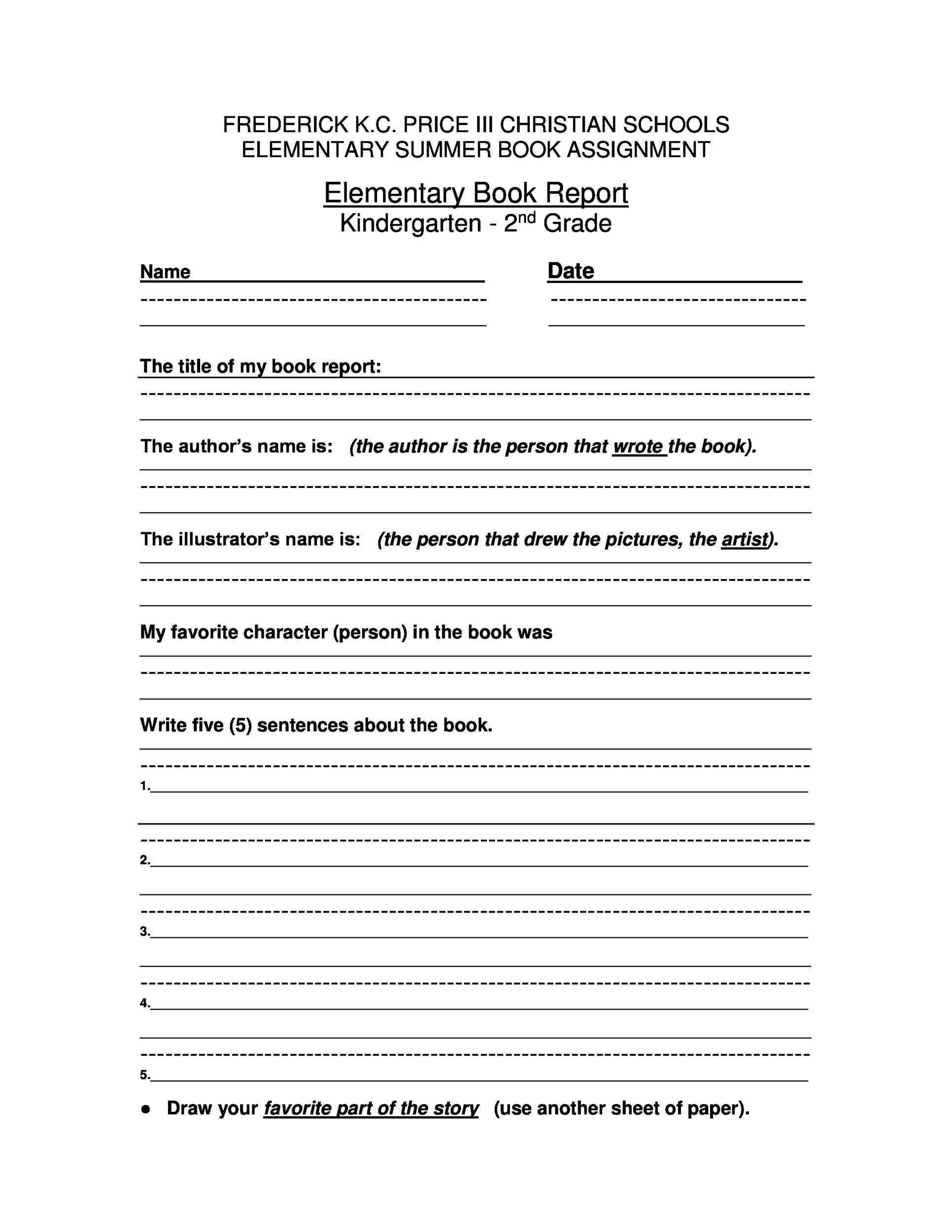
Tips for Teachers
Book reports are a big part of the curriculum. That doesn’t mean they have to be a lot of work for the students or the teacher. Make assigning these reports less of a hassle with these tips.
- Assign one book for the entire class to read. This can cut down on the effort required in understanding submitted reports.
- Pick out a short book report template to use. There is no need to use valuable time in creating one from scratch.
- Print out more copies of the form than are needed. Some students may lose theirs and need an extra form.
- Make reminder announcements when a due date approaches. Remind students at least twice before a book report due date.
- Keep the word count requirement low. Teachers also have to spend more time reviewing longer reports.
- Consider creative alternatives to some written reports. When your curriculum includes a lot of book reports, give students the option of turning in a drawing, diorama, or another project as a break.
Tips for Students
Being assigned a book report to complete can seem like a daunting task, especially if if you have never written a multi-page report. Make sure you don’t fall behind on the work by following a few of these tips.
- Make up a reading schedule to complete the book well in advance of the report being due. Use a calendar to remind yourself.
- Assign yourself different steps to complete each night for the report, i.e. make an outline, write 200 words, or revising
- Ask the teacher for help with ideas if you can’t figure out how to get started.
- Look for examples of completed reports to see how they are structured.
Book reports vary in their length and complexity. Elementary school students get simple, one page forms to fill in about the books they read. Those in middle school and high school usually have to write multiple page reports. Nearly all reports require students to talk about the plot, theme, characters, and how they liked the book. Both students and teachers can find a lot of templates to use. Those looking for something generic for students to fill in after reading a book can pick up a .pdf or .jpg form. Those who want more control over the look and wording of the template should download a .doc file.
More Templates

Homeschool Schedule Templates
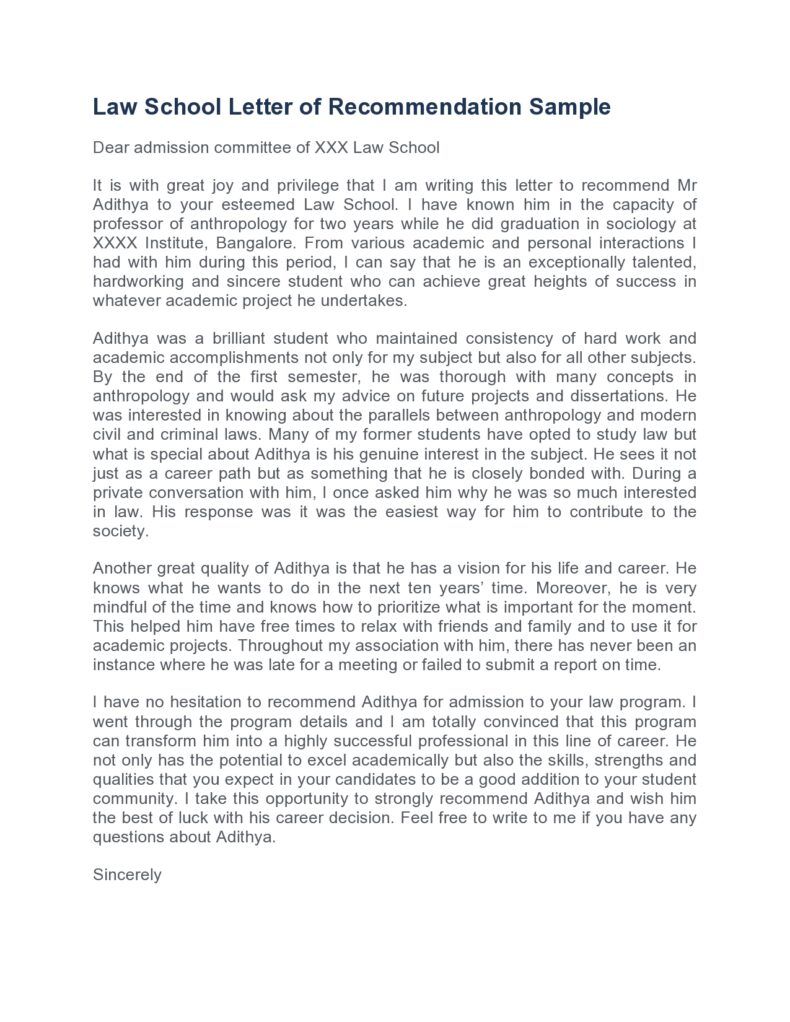
Law School Letters Of Recommendation
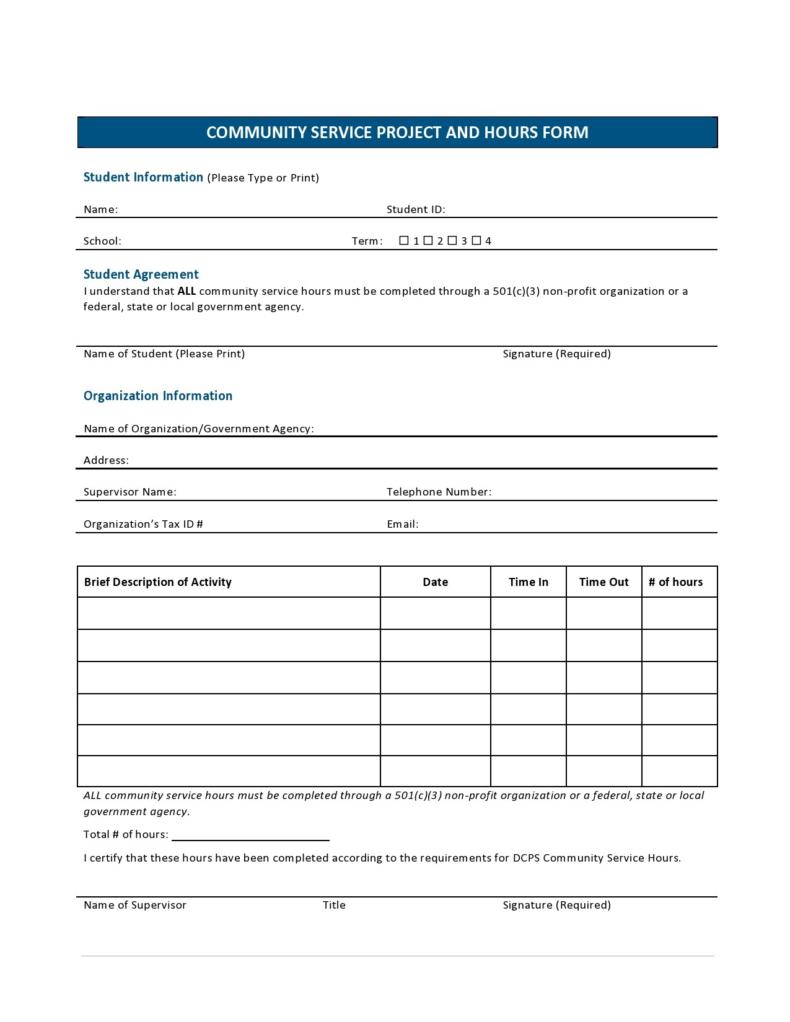
Community Service Forms
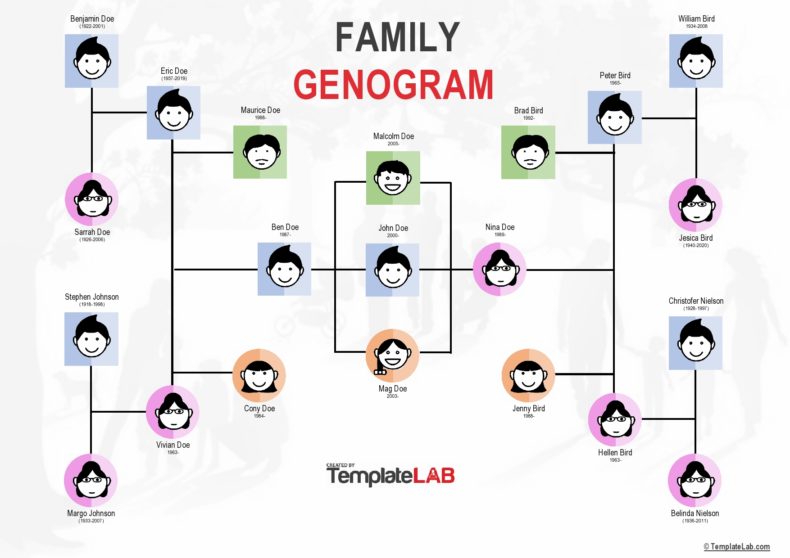
Genogram Templates
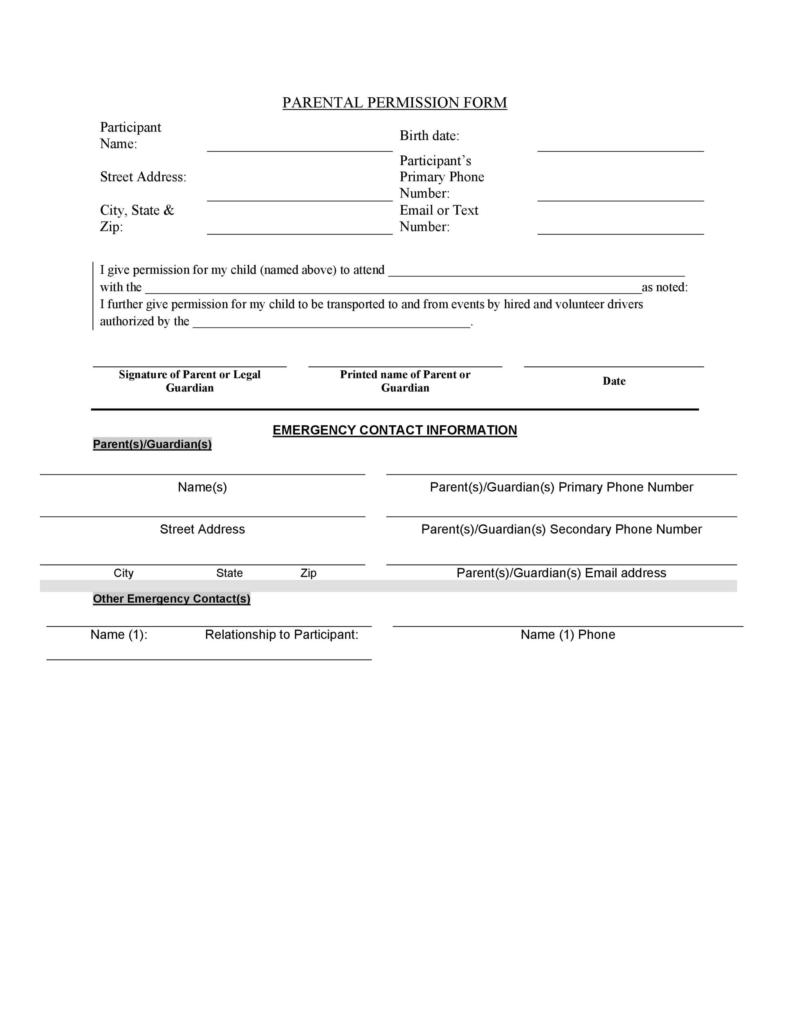
Permission Slip Templates
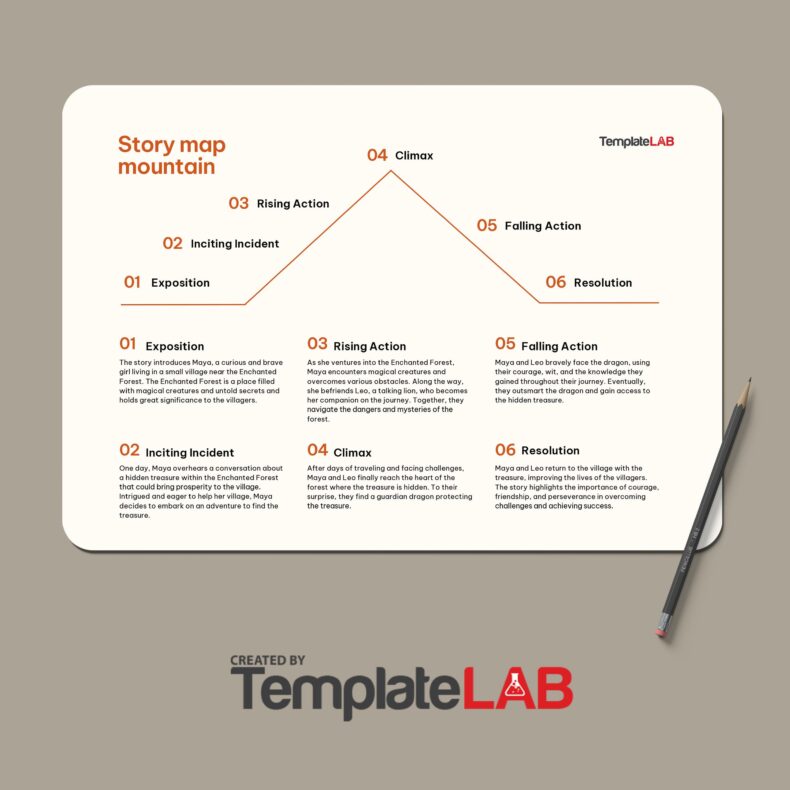
Story Map Templates

IMAGES
VIDEO